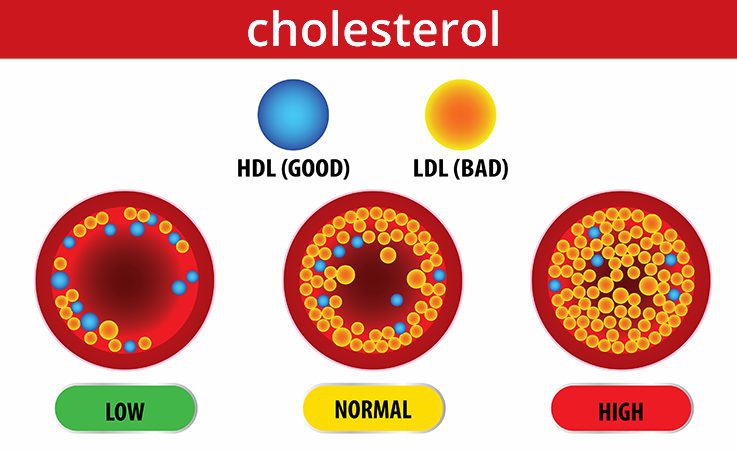Managing High Cholesterol
Heart Foundation
What is cholesterol and why is high cholesterol bad for you? Find out how high cholesterol can affect your heart and how to lower it.
What is cholesterol?
Cholesterol (matū ngako) is a fat-like substance in your blood. It comes from two places:
- some is made naturally by your liver
- some comes from the food you eat.
Cholesterol isn’t always ‘bad’. Your body needs some cholesterol to work properly. It uses it to develop cells and hormones, and to process and digest fats. But, if the amount of cholesterol in the blood gets too high, it can cause a heart attack or stroke.
Types of cholesterol
There are two types of cholesterol:
- low-density lipoprotein (LDL cholesterol)
- high-density lipoprotein cholesterol (HDL cholesterol).
LDL cholesterol
LDL cholesterol is sometimes called ‘bad cholesterol’. When you have too much LDL cholesterol it builds up in the arteries (the blood vessels that carry blood and oxygen around the body).
The build-up of cholesterol causes lumps of hard fat called plaque to form on the artery walls. These can break off, block the artery, and cause heart attacks and strokes.
HDL cholesterol
HDL cholesterol is the ‘good’ cholesterol. It works like a cleaner, carrying LDL cholesterol out of the arteries to your liver, where it is broken down and used by the body.
Triglycerides
Triglycerides are another type of fat in your blood.
When we eat or drink our body turns any energy (calories) that it doesn’t need into triglycerides, which are then stored in fat cells.
Triglyceride levels normally rise after we’ve eaten, but when we consume more energy than our body needs they stay at a high level, rather than returning to normal.
This is particularly true if our diet includes lots of refined sugar. This includes:
- foods high in added sugar, like sweets, baked goods and chocolate
- low fibre carbohydrates, like white bread
- alcohol and fizzy drinks, which include lots of extra sugar.
Like cholesterol, high triglycerides can increase the amount of plaque (hard fat) in the artery walls.
Cholesterol tests
The only way to measure cholesterol is to get a blood test. Sometimes your doctor will call this blood test a ‘lipid profile’ or ‘lipid test’. Lipid is another word for fat, so this test includes your cholesterol and your triglyceride levels.
Usually you will have to go to your closest laboratory (lab) for the blood test. Sometimes the practice nurse can take the blood at your doctor’s practice.
Some New Zealand pharmacies also offer a cholesterol testing service. This is a finger-prick test that measures the same things as the blood tests. If the reading is high, your pharmacist will send you to your GP for a follow-up appointment.
When should I get my cholesterol levels checked?
If you haven’t had a cholesterol test before, talk to your doctor or nurse about when you should have one.
If you’re at higher risk of heart attack or stroke because of your or family’s health history, then you may need one at a younger age.
Cholesterol tests are given routinely as part of a heart health check.
If high cholesterol runs in your family, you may need to have a check as early as in your teens.
Understanding cholesterol readings
The results of your blood test will include your levels of:
- HDL cholesterol (‘good cholesterol’)
- LDL cholesterol (‘bad cholesterol’)
- triglycerides
- total cholesterol. This is the total amount of cholesterol in your blood, which is the HDL and the LDL added together.
- total cholesterol/HDL ratio (cholesterol ratio). Your cholesterol ratio is important because it shows the amount of ‘good cholesterol’ versus the amount of ‘bad cholesterol’.
Healthy cholesterol readings
There isn’t a normal cholesterol level that applies to everyone. Your ideal cholesterol level depends on your overall risk of heart attack and stroke. To help know this, your GP or other health provider may do a cardiovascular risk assessment.
If you are at high risk of a stroke or heart attack you should aim to have an LDL cholesterol level less than 1.8 mmol/L.
What is high cholesterol?
High cholesterol is when there’s too much bad cholesterol (LDL) and/or not enough good cholesterol (HDL) in your blood.
Cholesterol. Blue dots represent good cholesterol (HDL) and yellow dots represent bad (LDL). Lots of yellow dots in an artery is bad. A mix of yellow and blue is normal.
Sometimes health professionals talk about the terms dyslipidaemia and hyperlipidaemia. Both are clinical terms that mean your levels of cholesterol are outside the normal range.
Symptoms of high cholesterol
You won’t know if you have high cholesterol because it doesn’t usually have symptoms. The only way to know is to have a blood test.
Why does high cholesterol matter?
When your cholesterol is too high it can build up as plaque in your arteries. If the plaque gets too big, or breaks off, it can cause a heart attack and stroke. This risk also increases when your triglycerides are too high.
Your doctor will use the results of your blood test and your other heart attack risk factors to decide whether you need medication to lower your cholesterol or triglyceride levels.
What causes high cholesterol?
Different things that can cause high cholesterol. Some of these causes you can change and some of them you can’t.
Risk factors you can change:
- Too much food high in saturated fats, like red meat, butter, cream, and other dairy products
- Too many foods with refined sugars, such as sweets, baked goods, white bread and fizzy drinks
- Too much alcohol
- Not being active enough each day
- Smoking
- Having too much body fat, especially around the middle
The good news is there’s lots of ways to manage these risks. Read about lowering your cholesterol.
Risk factors you can’t change:
- Family history
- Age
- Biological sex (whether you’re male or female)
- Other medical conditions such as kidney or liver disease, or hypothyroidism.
Some high cholesterol conditions that are passed down through families, including:
- familial hyperlipidaemia (high lipid levels)
- familial hypercholesterolaemia (high cholesterol levels)
- familial hypertriglyceridaemia (high triglyercide levels).
If you have one of these conditions, you may not be able to reduce your levels using lifestyle changes alone. You may need to go on medication as well.
If you have a parent or sibling with one of these conditions, talk to your doctor about getting your cholesterol checked. These conditions usually start at a younger age and can affect people in their teens or twenties.
How to lower cholesterol
If you have high cholesterol, your doctor may recommend lifestyle changes, medications or both.
Here are some ways to manage your cholesterol.
Eat heart-healthy food
What you eat can make a big difference to your cholesterol levels.
Cut back on foods high in saturated fats like:
- pies
- cakes
- chips.
And eat a wide variety of heart-healthy foods like:
- whole grains
- nuts and seeds
- fruits and vegetables
- oily fish.
Drink less alcohol
Drinking too much alcohol can increase your LDL cholesterol and triglycerides. So drinking less is a good way to lower your cholesterol.
The Ministry of Health recommends no more than 10 standard drinks per week for women and no more than 15 for men. One standard drink is equal to:
- a standard can of 4% beer (300ml)
- a small glass of wine (100ml)
- a small single shot of spirits (25mls)
If you have high cholesterol or you’ve been diagnosed with a heart condition, you may need to drink less than this.
Quit smoking
Smoking makes your LDL cholesterol (bad cholesterol) stickier and reduces the amount of HDL cholesterol (good cholesterol) in your blood. It also damages the artery walls. This increases the build-up of plaque in your arteries and can cause risk of heart attack and stroke.
Quitting smoking is a great way to lower your cholesterol levels and reduce your risk of heart disease.
Move more
Sitting less and being more active are great ways to reduce high cholesterol.
This doesn’t mean you have to join a gym or take up running – it just means you need to move your body more throughout the day. Ideally you should do 30 minutes of activity a day.
You could try:
- using the stairs not the lift
- parking 10 minutes away from your work or getting off the bus a stop early
- walking the dog twice around the park instead of once
- taking a walk outside during a break at work
- Having a swim or walk at the beach with family
- doing half an hour of gardening or cleaning.
Cholesterol medication
Your doctor may recommend that you take medication to lower your cholesterol. If you take this medication as directed it helps lower your chance of having a heart attack or stroke.
Usually this will be from a group of medications called statins.
The benefits of taking a statin usually outweigh any side-effects. If you experience unpleasant side-effects, talk to your doctor about them. Sometimes they can change the type of statin that you’re on, or adjust your dose. Never stop taking your cholesterol medication without talking to your doctor first.
Natural remedies and lowering cholesterol
It’s very important to talk to your health professional before using any:
- supplements
- vitamins
- natural remedies
- or complementary therapies.
Sometimes they can do more harm than good. They may interact with any medication that you’re taking, which can be dangerous. They can also make your medication less effective. Your doctor needs to know everything that you are taking to ensure that the combination is safe.
If you’ve been prescribed cholesterol-lowering medication, make sure you take it as directed by your doctor. This is one of the most effective ways to keep your cholesterol levels down.


